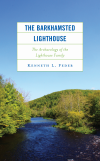Zusammenfassung
Deep in the woods of Barkhamsted, Connecticut, archaeologist Kenneth Feder found a series of irregular cellar holes. That discovery led to the archaeological and genealogical investigation into what had become the legend of Barkhamsted Lighthouse. The long told story as it appeared in local newspaper articles, a school play, and even a book-length poem focused on Molly Barber, a white woman born in central Connecticut in the middle of the eighteenth century. Molly, the legend goes, abandoned her family, her friends, and her privilege to marry the man she loved, James Chaugham, a Narragansett Indian from Block Island in Long Island Sound. Molly and James ultimately had several children and their growing community became a magnet for other outcasts including Native Americans as well as people of African and European descent. Some of these newcomers married into the family and together created a community in their little village.
As a tale of rebellion, race, resistance, and resilience the legend called out for investigation. The site was excavated intermittently between 1986 and 2009, and Feder also started a genealogical investigation of James and Molly and their descendants. After meeting with Raymond Ellis, a seventh-generation descendant of the founding couple, Feder recognized that this was more than just a historical mystery to solve, it was also a chance to connect archaeology of historic places with the present-day relatives of those who once lived there.
Schlagworte
Native Americans Narragansett Narragansett people Molly Barber archaeology for descendant communities archaeology of outcast communities archaeology with descendant communities Lewis Mills James Chaugham Barkhamsted Barkhamsted Lighthouse Connecticut Connecticut history multi-cultural village historical archaeology historical legendsKeywords
genealogy archaeology- Kapitel Ausklappen | EinklappenSeiten
- i–xii Preface i–xii
- 173–176 References Cited 173–176
- 177–184 Index 177–184
- 185–186 About the Author 185–186

